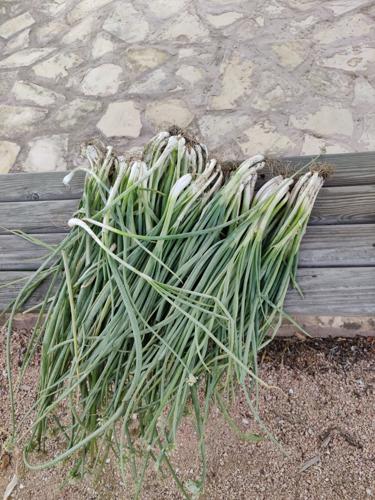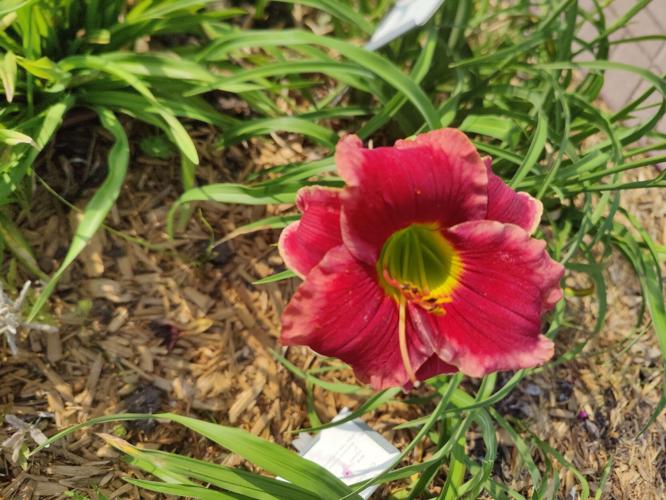ROOT REVOLUTION: Do you know the difference between a sweet potato and a yam?
Gardeners’ Dirt article by Sandi Coleman/Victoria County Master Gardener
Sept. 30-Oct 01 as published in the Victoria Advocate

Green onions
Contributed Photo by Sandi Coleman | Victoria County Master Gardener

Parts of the daylily are edible
Contributed Photo by Sandi Coleman | Victoria County Master Gardener

Daylily – PHOTO CONTRIBUTED BY SANDI COLEMAN/VICTORIA COUNTY MASTER GARDENER

Red potatoes
Contributed Photo by Sandi Coleman | Victoria County Master Gardener
Earlier this year a fellow Master Gardener asked me to speak to the Kids Camp on root vegetables. I accepted the invitation. Now I had to do my research. Boy, was I surprised about root vegetables.
They are much more than potatoes and carrots. Let me explain and introduce you to a few unusual root vegetables.
Root vegetables are plants that grow underground. Their main use is for food. Root vegetables absorb nutrients from the soil, which makes them have the highest concentration of antioxidants, Vitamins C, B, A, and iron in the world.
The primary function of root vegetables is storage. They store slow-release carbohydrates and fiber. These features help your body regulate blood sugar and to feel full.
Yams, beets, parsnips, turnips, rutabagas, carrots, yuca, kohlrabi, onions, garlic, celery root, horseradish, daikon, turmeric, jicama, sweet potatoes, radishes, ginger, taro and Chinese water chestnut are all root vegetables. Each root vegetable contains its own set of health benefits.
Root vegetables make one think, why would I want to eat this food? They have thick, strange looking skin and long stems with leaves sprouting out of them. Please, do not judge a vegetable by its appearance.
They are most desirable when cooked. For those who prefer their vegetables raw- carrots, beets, radishes and jicama are good choices.
Taro is a root vegetable, also known as elephant ears. It has been cultivated for more than 6,000 years and is one of the oldest cultivated plants. Taro is native of Southeast Asia and Southern India. In China, Japan, and the West Indies, taro is an important food crop.
Each culture uses Taro in a unique way. Taro is grown for its corms and lateral tubers. The corms and tubers cook just like a potato, roasted, fried, boiled, sliced, mashed or grated. Taro has a mild and nutty flavor. Do not eat taro raw but cook it to remove any toxins.
To my surprise I discovered that a daylily is an edible plant. There are four different edible parts. You can eat the tubers, young shoots, flower buds and flowers.
Each part has a different flavor and texture. They can be eaten as a stand-alone side dish or added to soups, stews and salad.
Daylilies originated in Asia. In the United States they can be found growing wild. In fact, in some states they are annoying weeds. Wild daylilies are a fortunate sight for serious foragers.
Be certain your plant is a daylily, Hemerocallis, as lookalike lilies can cause some serious gastrointestinal issues as well as other symptoms. The most flavorful daylilies come from the common variety, Hemerocallis fulva, which have yellow flowers.
At one of my presentations, I was asked what the differences between sweet potatoes and yams are. I did not know, so I did a little research. Both sweet potatoes and yam are tuber vegetables, a type of root vegetable, and are actually very different. They belong to different plant families.
Yams are sweeter than sweet potatoes, grow much larger and have less nutritional value. Sweet potatoes are elongated yellow or orange tubers that taper to a point at each end.
Sweet potatoes are used in both savory and sweet dishes, most often baked, mashed or fried. When it is pureed, it can be used in soups as well as baked foods and desserts.
The yam tuber has brown or black scaly skin which resembles the bark of a tree. The flesh of a yam is off-white, purple or red, depending on the variety. Yams are most often boiled, roasted, or fried.
I have enjoyed researching root vegetables and hope you have found that they are more than potatoes and carrots.
The Gardeners’ Dirt is written by members of the Victoria County Master Gardener Association, an educational outreach of Texas A&M AgriLife Extension – Victoria County.
REFERENCES:
Gardening Know How: Are Daylilies Edible – Can I Eat Daylilies